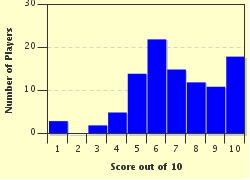Quiz Answer Key and Fun Facts
1. At the end of the twentieth century how many gases were confirmed as proud members of the noble gas club?
2. Which group of the periodic table are the noble gases?
3. Which of these men, with scientific backgrounds, would be considered to be the first to discover the evidence of noble gases present in the air?
4. Which noble gas is notable for its use as the agent that inflates party balloons?
5. A finding that shocked the scientific world in 1962 was the discovery of the first noble gas compound. What noble gas was a constituent of this compound?
6. This noble gas is the third most abundant gas in the atmosphere that we breathe. What is it?
7. This noble gas was discovered from studying the decay chain of radium. What is it?
8. What noble gas was not discovered via the process of capturing gases from boiling liquid air?
9. Which of these noble gases has the lowest boiling point of any substance?
10. The flashing bright-lighted sign of your favorite bar and part of the name of a 1991 hit by Brooks and Dunn both contain this gaseous element. What is it?
Source: Author
genetheking
This quiz was reviewed by FunTrivia editor
rossian before going online.
Any errors found in FunTrivia content are routinely corrected through our feedback system.

